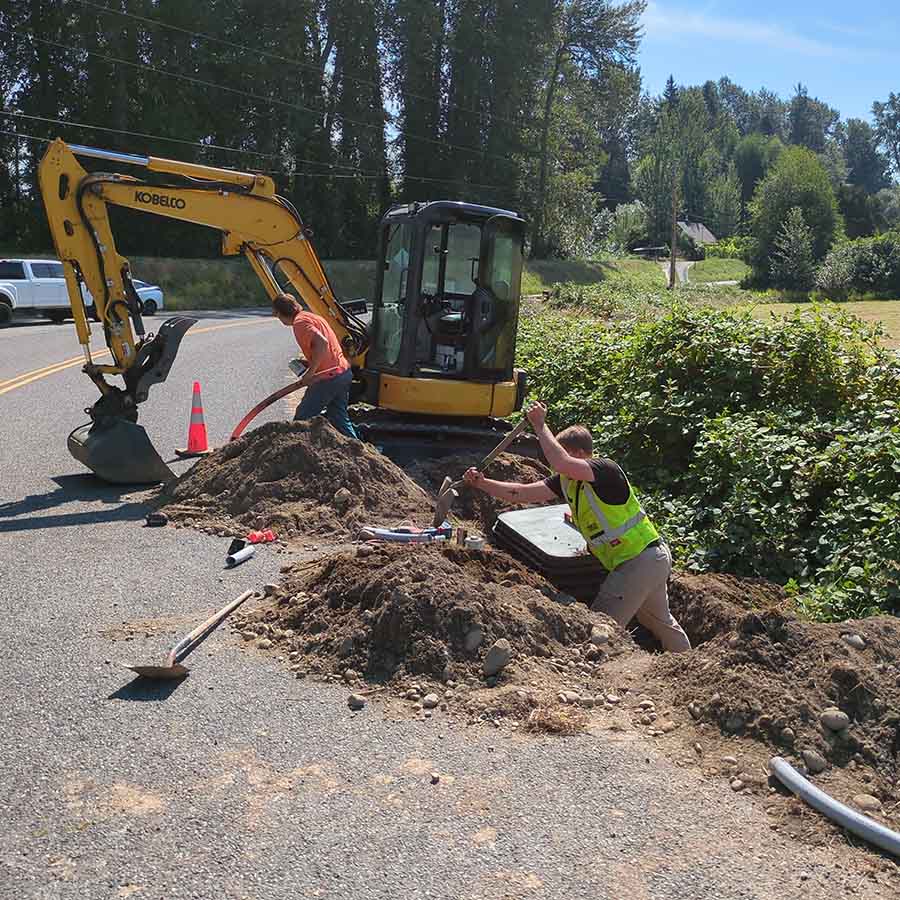Internet options are limited and expensive for those living in “the last mile.”
Debra Anderson-Frey couldn’t swallow the $10,000 it would’ve cost to connect her home to fiber optic internet.
She lives at the end of a gravel road in northeast Whatcom County, about five miles from the Canadian border. It’s rural, certainly, but it’s also located in what telecommunication providers have dubbed the “last mile,” or the final leg of infrastructure needed to connect the broader internet network to individual homes.
The last mile is often the most expensive and logistically challenging part of broadband expansion since utility companies must physically reach each customer. When Anderson-Frey heard the broadband line was being extended onto her road, she immediately began calling local representatives to find out more.
Eventually, however, she said she was told the extension wouldn’t reach all the way to her home and that she and a dozen or so neighbors could organize and split the cost of extending fiber optic to their homes.
“(It) would have been formidable, like $10,000 apiece. That wasn’t going to happen, so I just gave up,” Anderson-Frey said. “Part of me felt like I thought the government was supposed to help organize the community to bring down essential services like utilities.”
Instead, Anderson-Frey said her internet options are limited to a cellular hotspot device and Starlink. Although most of her neighbors use the satellite internet provider, Anderson-Frey said her decision not to switch over is a political one.
Access … for all
Anderson-Frey isn’t the only Northwest Washingtonian in the last mile. Only 41% of residents in San Juan County, 89% in Whatcom County and 86% in Skagit County have access to fixed broadband, according to the Federal Communications Commission.
Although projects are in play to bridge gaps in broadband access, concerns remain about the timeline and affordability.
Most notable among those efforts is the Broadband Equity Access and Deployment Program, or BEAD for short. The federal program is pumping over $42 billion into broadband expansion with the aim of connecting every American to high-speed internet.
The state submitted its proposal for $1.2 billion in funding awards to the feds in September. The administration was supposed to approve it within 90 days, but the government shutdown will likely extend that timeline out to next year.
The odds are that residents won’t see the impacts until 2026 or longer depending on the type of infrastructure that would specifically serve them. The program, however, requires projects to be completed by 2030.
“The fiber folks, who knows — it depends on how far they are from the lines as they’re being strung. The fixed wireless, they could be connected as early as the end of summer. And then the low-Earth orbitals (satellite), could be connected right away,” said Joseph Williams, Washington State Broadband Office interim director.
Broadband barriers
One of the biggest barriers to connecting rural areas is typically distance, Williams said.
“The more rural and more remote, the harder it is to connect,” he said.
That issue has been compounded by the unique geography and terrain in parts of Whatcom, Skagit and San Juan counties. Installing fiber on islands not served by state ferries, for example, requires additional logistical planning and funds to get workers and materials on site. Likewise, heavily forested areas and the fire exposure that comes with them means fire resiliency needs to be taken into account when deciding what types of infrastructure to build.
“It’s just too costly to get out there and make a business case for it to work, which is exactly why the private providers haven’t done that so far, right?” said Andrew Entrikin of Whatcom PUD. “If it penciled and made sense to reach these locations that are hard to reach, they would have done it already.”
Instead, public utilities have stepped in to fill those gaps in Whatcom, Skagit and San Juan counties, with stakeholders in each making big strides in expanding access. In Skagit and Whatcom, public utilities have been working to build infrastructure that is then used by private providers.
“We didn’t get in necessarily to try to bring broadband to every resident of Skagit County; we’re there mostly to be gap fillers,” Port of Skagit Executive Director Sara Young. “It’s base infrastructure, and you hope that it will continue to proliferate once you’ve kind of got the solid core of infrastructure there, then the private sector can take it on and continue to build out user connections over time.”
In San Juan County, in contrast, the local broadband provider, Rock Island Communications, is owned by the county’s utility co-op, OPALCO. That dynamic has allowed Rock Island to utilize OPALCO’s existing infrastructure, such as stringing on fiber optic cables on existing power lines.
“I don’t know that it would be super possible to get as far as we have gotten at this point If we weren’t owned by OPALCO,” Rock Island spokesperson Ali Boe said. “It really helps us make headway in spots that otherwise would be doable, but just would take a lot more time.”
BEAD potential
What will the BEAD program do in Northwest Washington?
In Skagit, Whatcom and San Juan counties, nearly $69 million in BEAD funds and state and private matches are projected to connect 13,812 new locations through a mix of fiber optic, fixed wireless and satellite internet.
Overall, however, wireless is the most common type of project funded by BEAD in the tri-county area, making up 74% of projects. Meanwhile fiber makes up 17% of projects, and satellite is 9% of projects.
That’s somewhat of a change for most counties, which have historically favored fiber optic over other technologies since that’s been the focus of most of the funding opportunities. Earlier this year, however, the Trump administration changed the BEAD program to require states to be technology neutral when reviewing grant applications. That opened the door for funding to go to satellite and fixed-wireless companies, including Starlink and Amazon.
Young said that while wireless solutions are inevitable given the difficulty in getting land-based infrastructure to certain areas, they also “can’t exist in a vacuum.” In fact, each wireless solution requires a fiber optic network to help mitigate latency requirements.
“So having fiber optics in the communities, even if it’s not connecting fiber to the premise, you still need to have backbone infrastructure to really make these systems work,” she said.
Virginia-based Declaration Network Group will receive the largest share of BEAD funds in the counties at 37%, followed by Rock Island Communications at 32%, the Port of Bellingham at 27%, Starlink at 2.6%, Amazon at 0.6% and Starlink at 0.2%.
Skagit County is the only county among the three where a public utility was not chosen as an awardee. The Port of Skagit applied for the funds but wasn’t selected.
Here’s a breakdown of the projects in the tri-county area:
Skagit ($13.8 million)
4,084 new locations served
91% wireless, 9% satellite
Awardees: Starlink, Declaration Network Group and Amazon
Whatcom ($32.8 million)
5,684 new locations served
60% wireless, 26% fiber and 14% satellite
Awardees: Amazon, Port of Bellingham, Declaration Network Group and Starlink
San Juan ($22.3 million)
4,044 new locations served
77% wireless, 22% fiber, 1% satellite
Awardees: Starlink and Rock Island Communications
Remaining gaps
While the BEAD program will connect many Washingtonians, the affordability of broadband is a huge barrier for a lot of folks in the state, according to State Broadband Office policy and comms manager Devin Proctor.
“While we can make broadband solution technology available to all the underserved and unserved locations around the state, actually getting them connected with the affordable internet is another discussion we’re going to have to have over the next several years as a state,” Proctor said. “We don’t want to end up in a situation where we’re leaving people behind just because they can’t afford access.”
The State Broadband Office has spoken with legislators about the affordability issue, it’s been a tough sell due to the state’s strapped budget. According to the National Telecommunications and Information Administration, the Trump administration dropped the affordability requirements contained in the original program and priority to underserved communities among other changes.
Since the BEAD program also only covers residences that existed prior to 2025, which could potentially leave new households without coverage. To address that issue, the State Broadband Office is also pushing to include broadband as a planning requirement for new developments.
In the meantime, Williams said, satellite coverage is available in the vast majority of the state. Libraries and other community centers can also bridge the gap with free Wi-Fi and rentable mobile hotspots.
Individual counties also have programs. OPALCO and Rock Island Communications in San Juan, for example, have programs to help members finance fiber internet connection.
Eligible individuals can also apply for the federal program Lifeline, which offers up to $9.25 off the cost of phone and internet services each month. Rock Island Communication subscribers who are approved for Lifeline can also get a $30 total discount.
“Our rates are higher out here than a company like Comcast, or even T-Mobile’s home internet is quite a bit cheaper, but we’re just a lot smaller. We’re in a very expensive place too,” Boe said. “So we try to balance that out, because not everyone who lives out here is wealthy by any means.”
For those who are still waiting for broadband access, Whatcom PUD’s Entrikin said it’s important for individuals to check their addresses on the FCC Broadband map, which is used in programs like BEAD to determine which homes are still unserved or underserved and to give utilities and providers feedback about their broadband access to help shape future projects.
“Without folks letting us know, we have to rely on publicly available data sources to identify where these locations are served and not served. And they’re not always accurate,” Entrikin said. “In theory, everybody will be served after BEAD — but I think there will still be folks who are not served after this BEAD program. I think that’s just how it’s going to shake out.”
By Sydnee Chapman

Also read in Salish Current:
• “Tyler Schroeder to lead Port of Bellingham economic development,” Feb. 29, 2024
• “Commentary: Affordable Whatcom broadband is on the way,” April 21, 2023
• “Broadband’s coming but cost, quality still in question,” March 4, 2022
• “Major funding, new policies aim to provide ‘basic necessity’ of broadband,” May 28, 2021
• “Internet connectivity has improved in Whatcom; gaps remain,” Feb. 25, 2021
• • •
Did you find this story useful? If so, share it with a friend, a family member or colleague
and ask them to subscribe to Salish Current (it’s free) for more stories like this.
We welcome letters to the editor responding to or amplifying subjects addressed in Salish Current.
Got an idea for a Community Voices essay? Email your subject proposal to Executive Editor
Mike Sato (msato@rockisland.com) and he will respond with guidelines.
Help keep the local news flowing — support nonpartisan, fact-based, no-paywall local journalism
with a donation to Salish Current — news for people, not for profit.

